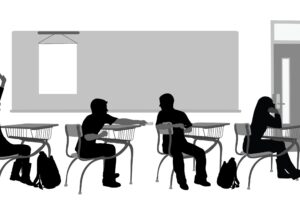
5 Strategies for Creating a Sensory-Friendly Classroom
21.5K
Every student is a unique individual who learns differently and has different needs. That’s why educators take special care at the start of every year to set up their classrooms in a way that supports the needs of all their learners. Creating sensory-friendly spaces is just one step toward building inclusive and supportive environments where all students — and particularly, those with sensory processing challenges — can thrive.
Everything about your classroom design, from the wall displays to the lighting, can make a difference in student learning. Recent research from the University of Salford in England found that an effective classroom environment and layout can boost student achievement by nearly 16%! So, get ready to explore some sensory-friendly classroom strategies that can help your students soar to new heights.
1. Build a space that’s free of visual overwhelm
Maintaining focus is something that all students may struggle with at one point or another — but for autistic students or students with ADHD, it can be particularly challenging. According to a 2021 study, colorful, richly decorated environments might be perceived as a cacophony of visual noise for students who have sensory issues. So, when it comes to creating a sensory-friendly environment, less is often more!
To cut down on visual noise:
- Choose either muted or neutral colors when decorating your classroom.
- For wall displays, make sure there’s a balance of white space and visually engaging elements.
- Make sure what you hang up has a purpose. For example, you can use the front walls of your classroom to display daily materials, like calendars, learning objectives, or visual schedules.
- You can also align any decor with the content you’re currently teaching. That way, if students get distracted by what’s on the walls, they’re still focusing on relevant information.
Special Education Focus Wall: Sensory Friendly Classroom Decor in Calming Greens
By Adapted by Kimmie D
Grades: PreK-2nd
This sensory-friendly classroom decor is designed to support speech therapy and enhance learning for special education students. With a focus on minimizing overstimulation, the black-and-white visuals are perfect for neurodivergent students who thrive in a structured yet soothing setting. It includes over 200 black-and-white cards.
2. Organize your classroom clutter
In general, organizational tools are a teacher’s best friend, but even more so for a sensory-friendly classroom. Good classroom organization can help students feel comfortable and in control of their environments, and it helps you manage your time efficiently and effectively.
Make use of labeled trays and tubs, designated storage areas, and other classroom organization tools to declutter your space and ensure that everything has a place. Keep in mind: It doesn’t need to look social media perfect to be clutter-free. You just need to choose the tools that work for you.
Boho Rainbow Classroom Decor Organization, Roller Cart, & Book Bin Labels
By The SuperHERO Teacher
Grades: Any
These beautifully designed organization, book bin, and roller cart labels are created for a muted rainbow-themed classroom! The set also includes an editable file, so you can create any labels that do not already exist within the set.
Teacher Toolbox Labels Editable Boho Classroom Decor Neutral Modern
By Differentiation Corner
Grades: Any
This editable teacher toolbox label set is very easy to edit in PowerPoint. There are also clear instructions and teacher tips included to make editing even easier, and the labels fit most common classroom drawer units.
3. Incorporate practices that minimize noise
Noise is often something that can bother or overwhelm students with sensitivities. While you might not be in a position to use carpets or provide students with noise-canceling headphones (which are great to do, if you can), there are other things that you can try to create a quieter classroom environment.
Voice level displays, for instance, are a great classroom management tool that can help students understand the voice level needed for each activity. You can also encourage non-verbal communication in the classroom by employing hand signals as a way to ask for things, like a pencil or a bathroom break.
Voice Levels Chart | Ready to Print and Editable | Boho Neutrals
By Learning in Wonderland
Grades: K-3rd
This set of files includes a ready-to-print version as well as editable versions you can customize. The display can be used as is or add lights for an extra touch! (Three-inch puck lights will fit into the circles.)
Hand Signals Posters | SPOTTY PASTELS Classroom Decor | EDITABLE
By Miss Jacobs Little Learners
Grades: PreK-6th
Created using multicultural hand signal clipart, you can choose to simply print and go using the pre-made hand signals or customize them by adding your own text into the text box provided in the editable versions (PowerPoint & Canva) included in the download. Display these hand signs in a prominent position in your classroom so that your students can refer to them regularly.
4. Provide a designated quiet space for breaks
Designate a quiet area in your classroom where students can retreat if they start to feel overwhelmed for any reason. Having a space like this can help students reset when a sensory overload occurs, so they can continue with their learning. This space can also double as a calm down (or peace) corner to help kids who are struggling to cope with strong emotions like anxiety, stress, or frustration.
5. Offer flexible seating options
Including flexible seating in your classroom seating arrangements provides students with the option to choose what works for them. Maybe it’s standing at a table or sitting in a bean bag chair in a quieter corner of the room. Either way, the idea behind flexible seating is that students know what helps them learn best. Of course, this option may not be for every classroom — or every budget — but if you do decide to incorporate it, be sure to set rules and norms with your students.
Set up a sensory-friendly classroom with sensible resources from TPT
When creating sensory-friendly classrooms, work with the sensory-friendly classroom decor and resources you already have access to. You don’t need to make massive changes, as a little can go a long way. But most of all, remember that your efforts now will help ensure that every one of your students has what they need to succeed in their learning journey. While you might not have the ability to do or implement every sensory classroom idea, making even a few adjustments can do a world of good for your students’ ability to focus and learn.
Source link








